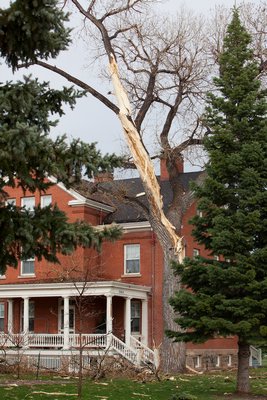

Whenever there’s a summer thunderstorm with lightning at night, I dread going to work the following morning. With more than 100 acres to manage on the top of a hill, with plenty of tall trees, in any summer we’ll invariably get a lightning strike; in some years, many. I’ve seen trees literally blasted out of the ground, while others have more subtle damage that’s noticed only days later, as the tree begins to brown and the strike line can be seen splitting the trunk from tip to ground. In most cases, the tree is killed, and in some cases nearby trees can suffer the effects of the jolt as well.
Lightning can strike at 100,000 miles per second, with the force of 10 million to 100 million volts at 1,000 to 300,000 amperes. This massive discharge of energy generates light, thunder, radio waves and heat up to 55,000 degrees Fahrenheit. And, yet, with all of this power and fury, when lightning strikes a tree, the outcome is never completely predictable: Each tree, and even a species of tree, will react differently.
A direct hit by a “hot bolt” can cause an entire tree to burst into flame, while “cold” lightning can cause a tree to explode—and that’s exactly the damage that I’d observed a number of years ago in a pine tree, a controlled explosion that literally split the tree in two from tip to base. And because this was a grove of pines, there also was damage to nearby trees whose roots were close enough to the tree that was hit to sustain root damage as well. Ultimately, three trees were lost, even though only one took a direct hit.
In other cases, trees can sustain lightning strikes with little apparent damage, only to die suddenly a few weeks later because the root system was destroyed by the heat of the strike. Many trees are hit with little or no short-term damage at all.
The extent of the damage is related to the intensity of the strike and the texture of the bark. The amount of water present outside and inside the bark at the time of the strike also is important. Nearby trees, plants and structures also can be damaged by the heat, or by “shrapnel” flying from the tree, or transient surges of electricity that may travel through the ground, wires or pipes in the general vicinity.
You can protect your trees to a degree, and your insurance company or a wise arborist may have suggested or insisted on some protection when you bought your house or when you last filed an insurance claim for lightning damage. Often, an insurance company will require lightning protection for trees of a certain height, and within a certain distance of a dwelling or structure. This is usually in the form of a thick copper cable that runs to the top of the tree and allows a lightning strike to be channeled down the cable, then deep into the ground via a grounding rod.
On the other hand, if you have tall trees with landscape lighting in them with no lightning protection, the landscape lighting can become a real problem, as it can act as the conduit for a power surge or direct strike that can then damage any number of other connected or even seemingly unrelated devices containing sensitive electronics.
Treatment for lightning-struck trees is based on the extent of the damage. If the tree is cracked or broken to the point of being hazardous, it should be removed immediately. A certified arborist should make this determination—not your gardener, or the guy who pulls up in a broken-down pickup truck with a ladder and a chainsaw.
Should the arborist determine that there is a chance for survival, and you would like to try to save the tree, there are a number of recommended procedures. But, remember, there is always the risk that the unseen damage may result in the tree still being lost months or a year down the road. In some cases, your arborist may recommend that no work or extensive repairs be done for six to 12 months so that the full extent of the damage will be more apparent.
The tree should be made as safe as possible by pruning any broken, hanging or large cracked limbs that could fall and cause damage. Any deadwood present also should be removed. When large sections of bark are blown loose and the wood beneath is still moist, the bark can be tacked back into place in a procedure akin to a skin graft. A moist “bandage” of burlap placed over the wound will help prevent drying. This procedure sometimes results in the bark reattaching to the trunk.
Where the trunk injury is severe, damaged bark can be traced back to healthy wood. Light fertilization, depending on the tree and the time of the year, may be recommended to help the tree through the recovery process.
Lightning-damaged trees should be monitored during the growing season to ensure adequate soil moisture levels and to minimize any stress from insects and diseases. In some trees, the exposed wound may emit ethylene gas, which some insects can hone in on, as they perceive the gas as an indication of exposed tissue that they can easily penetrate or infect.
Mulching the tree to help conserve soil moisture also is important and may be recommended. Because lightning injury affects the water-conducting tissues, water conservation procedures are critical.
If the tree remains healthy after a full growing season, more extensive pruning may be needed to remove additional dead or declining branches. As noted, lightning protection systems can be installed to help prevent future lightning strikes in the same or nearby trees.
It must be clear to you, the owner, that internal damage to the tree is not visible and cannot be determined. With this in mind, you will understand the risks in trying to save a damaged tree, and the fact that in spite of the best efforts the tree may still die.
It’s possible that the tree may decline slowly over several years and may yet need to be removed. In a very stressful year in which many trees are hurting from the lack of ground water, it may end up being the last straw for a tree that was damaged one or two years ago.
Finally, remember that while lightning damage is most likely to happen in the summer months, it is possible to have a lightning strike in the dead of winter, and the damage can be equally as severe.
Keep growing!
 More Posts from Andrew Messinger
More Posts from Andrew Messinger